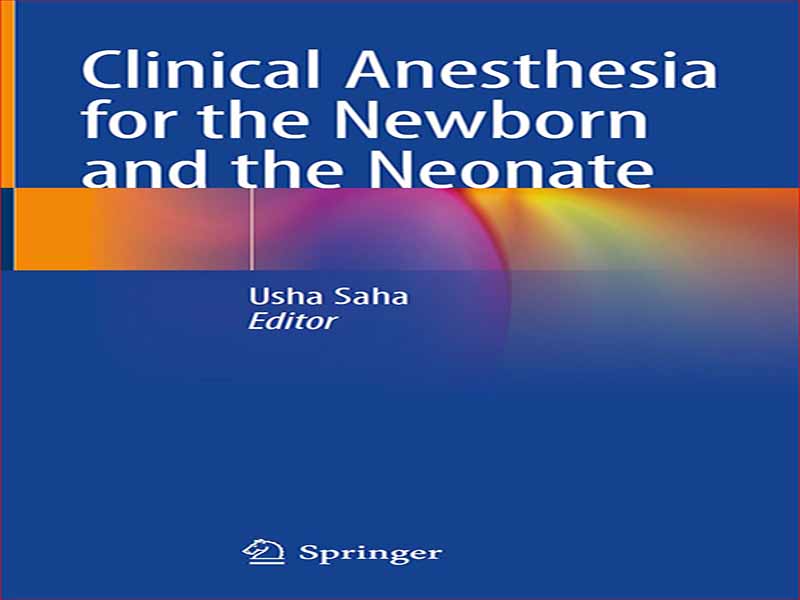- عنوان کتاب: Clinical Anesthesia for the Newborn and the Neonate
- نویسنده: Usha Saha
- حوزه: بیهوشی
- سال انتشار: 2023
- تعداد صفحه: 984
- زبان اصلی: انگلیسی
- نوع فایل: pdf
- حجم فایل: 29.5 مگابایت
سن نوزادی آسیب پذیرترین دوران زندگی یک انسان با بیشترین خطر مرگ در سنین اطفال است. مرگ و میر و عوارض نوزادان بار بزرگی در سراسر جهان است (ارقام در کشورهای در حال توسعه بالاتر است). مرگ و میر نوزادان 66 درصد از نوزادان (تولد تا 12 ماهگی) و 40 تا 60 درصد از میزان مرگ و میر زیر 5 سال را تشکیل می دهد. طبق برآوردهای سازمان ملل متحد در مورد مرگ و میر کودکان، 721000 مرگ نوزادان در سال 2018 رخ داده است (میانگین 1975 مرگ در روز). یونیسف ، در سپتامبر سال 2020 ، به طور متوسط NMR جهانی (میزان نوزادان نوزاد) 17 در سال 2020 ، 2.4 میلیون مرگ نوزادان را گزارش کرد که یک سوم در 24 ساعت اول و سه چهارم در هفته اول زندگی رخ داده است. هند به تقریباً یک پنجم تولد جهانی زنده ، بیش از 25 ٪ از مرگ و میر نوزادان و 27 ٪ از مرگ و میر نوزادان کمک می کند (ممکن است ارقام بیشتر باشد زیرا تعداد زیادی از مرگ ها گزارش نشده اند). علل عمده مرگ و میر اولیه نوزادان (7 روز تولد) آسفیکسی تولد ، عفونت ها ، عوارض تولد زودرس (44 ٪) و ناهنجاری های مادرزادی است. WHO و گروه تخمین اپیدمیولوژی مادر و کودک (MCEE) 2018 (http: //data.uni¬cef.org) دلایل اصلی مرگ و میر نوزادان را به عنوان عوارض زایمان زودرس (44 ٪) ، وقایع مربوط به intrapartum (19 ٪) ، سپسیس ذکر کرد. کزاز (13 ٪) ، ناهنجاری های مادرزادی (11 ٪) ، ذات الریه (5 ٪) ، اسهال (1 ٪) و سایر موارد مانند وزن کم هنگام تولد ، هیپوترمی و زردی نوزاد (7 ٪). میزان زایمان زودرس در سراسر جهان در حال افزایش است و عوارض مرتبط با آن نیز وجود دارد که مرگ و میر با سن حاملگی متناسب است. این ارقام نگران کننده است ، و دولت هند قصد دارد تا سال 2035 به هدف هزاره NMR (17 مرگ و میر/1000 تولد زنده) برسد. این شامل زودرس (متولد GA <36 هفته) ، برای سن حاملگی (SGA) و نوزاد ((SGA) و نوزاد (متولد شده است) ( در 24 ساعت پس از تولد) نوزادان. آنها نه مانند بزرگسالان هستند و نه در کودکان در فیزیولوژی آناتومی ، عملکردهای دارویی و داروهای دارویی و فارماکودینامیک ، توسعه غدد درون ریز ، هموپوئیت و سیستم NM را دوست دارند. مهمتر از این ، هیچ راهی وجود ندارد که آنها بتوانند شکایت خود را بیان کنند یا تاریخ را ارائه دهند ، و سابقه گذشته برای تکیه بر آن وجود ندارد و زمان محدودی برای ارزیابی و بهینه سازی وجود ندارد. آنها تمام مواد ممکن برای مرگ و میر بالای بعد از عمل را دارند. به طور عمده ، وزن کم هنگام تولد ، نارس ، سیستم های حیاتی نابالغ و حساس از جمله سیستم تنفسی ، قلبی عروقی ، کلیوی ، کبدی ، عصبی و عصبی عضلانی ، تأثیر وضعیت پزشکی و جراحی ، و مشکلات ناشناخته یا تشخیص داده نشده بیماری های پزشکی، نقایص مادرزادی). بنابراین آنها در یک مرکز مراقبت های سوم تخصصی با متخصص بیهوشی آموزش دیده ، نوزادان ، جراحان کودکان و سایر تخصص ها و امکانات پشتیبانی ، نیاز به مراقبت ویژه دارند. عوارض و مرگ و میر ناشی از بیهوشی در نوزادان و نوزادان بیشتر از کودکان و بزرگسالان است. نوزادان تازه متولد شده باید با محیط اضافی رحم سازگار شوند و این در دوره نوزادی ادامه دارد. بیشترین ترس از متخصص بیهوشی ، خطر بازگشت این تغییرات در هر زمان که شرایط نامطلوب حاکم باشد ، عمدتا هیپوکسیمی ، هیپرکربیا ، اسیدوز ، هیپوولمی و هیپوترمی که ممکن است مقاومت عروق ریوی و یا کاهش مقاومت عروق سیستمیک را کاهش دهد ، با بازگشت راست به سمت چپ به سمت چپ شانت داخل قلب متخصص بیهوشی باید هوشیار باشد و به طور فعال از وقوع این حوادث جلوگیری کند. اگر نوزاد بعد از 60 هفتگی پس از بارداری (دوره ایمن) جراحی شود، نتیجه پس از عمل بهتر است و اولین آن در 44 هفتگی است. از این رو، نوزادی که در 36 هفتگی متولد می شود، اگر بعد از 8 هفته تولد جراحی شود، شانس بیشتری برای زنده ماندن دارد و بعد از 24 هفتگی (6 ماهگی) بهتر است. این ارقام با سن حاملگی که در آن نوزاد به دنیا می آید تغییر می کند (کودک زودرس بیشتر است ، سنی که باید در آن عمل شود طولانی تر است). هر عمل جراحی در این دوره ها به عنوان یک اورژانس و تهدید کننده زندگی در نظر گرفته می شود. آسیب شناسی جراحی همچنین دارای اثرات جانبی آناتومیک، پاتوفیزیولوژیک، بیوشیمیایی، وضعیت حجمی، اسید باز و گاز مربوط به خود است، اعم از آنتروکولیت نکروزان (NEC)، فتق مادرزادی دیافراگم، فیستول تراکئو مری (TEF)، امفالوسل و گاستروشیز، مننژومیلوسل. و انسفالوسل، یا بد چرخش روده و ولولوس. علاوه بر این، جراحی به خودی خود بسیار استرس زا است و تأثیر منفی بر اندام های در حال رشد و مغز دارد، بنابراین توصیه می شود تحت بیهوشی انجام شود، که بیشتر به خطر رشد مغز، هیپوترمی و راه های هوایی و تهویه مربوط می شود.
Neonatal age is the most vulnerable period in the life of a human being with the greatest risk of death in the pediatric age. Neonatal mortality and morbidity are is a huge burden worldwide (figures being higher in developing countries). Neonatal deaths account for 66% of infant (birth–12 months) and 40–60% of under-5 mortality rates. As per United Nations’ child mortality estimates, 721,000 neonatal deaths occurred in 2018 (average 1975 deaths every day).
UNICEF, in September 2020, reported an average Global NMR (neonatal mortality rate) of 17 in 2020, 2.4 million neonatal deaths, with one-third occurring within the first 24 h, and three-fourth within the first week of life. India contributes to nearly one-fifth of global live births, to more than 25% of neonatal deaths, and to 27% of newborn deaths (figures may be higher as many deaths go unreported). Major causes of early neonatal deaths (birth–7 days) are birth asphyxia, infections, complications of premature birth (44%), and congenital anomalies. WHO and Maternal and Child Epidemiology Estimation Group (MCEE) 2018 (http://data.unicef.org) listed major causes of neonatal deaths as preterm birth complications (44%), intrapartum-related events (19%), sepsis tetanus (13%), congenital abnormalities (11%), pneumonia (5%), diarrhea (1%), and others such as low birth weight, hypothermia, and neonatal jaundice (7%). The preterm birth rate is on the increase worldwide, and so are the related complications, with mortality being inversely proportional to the gestational age. These figures are alarming, and Indian government aims to achieve the millennium goal of NMR (17 deaths/1000 live births) by 2035. that includes premature (born at GA < 36 weeks), small for gestational age (SGA), and newborn (within 24 h of birth) babies. They are neither like adults nor like children in their anatomy physiology organ functions drug responses and their pharmacokinetics and pharmacodynamics, endocrine development, hemopoietic, and NM system. On top of this, there is no way they can tell their presenting complaint or give a history, and there is no past history to rely on, and limited time for evaluation and optimization.
They have all the possible ingredients for high perioperative mortality; chiefly, low birth weight, prematurity, immature and sensitive vital body systems including respiratory, cardiovascular, renal, hepatobiliary, nervous and neuromuscular system, effects of the medical and surgical condition, and unknown or undiagnosed problems (chromosomal defects, genetic syndromes, medical diseases, congenital birth defects). They thus require special care in a specialized tertiary care center with trained anesthesiologist, neonatologist, pediatric surgeons, and other supporting specialties and facilities.
Anesthesia-related morbidity and mortality are higher in newborns and neonates than in children and adults. Newborn babies must adapt to the extra uterine environment, and this continues in the neonatal period. The greatest fear of the anesthetist is the risk of reverting these changes whenever adverse conditions prevail, chiefly hypoxemia, hypercarbia, acidosis, hypovolemia, and hypothermia that may increase pulmonary vascular resistance and/or decrease systemic vascular resistance, with the return of right to left intracardiac shunting. Anesthetist must remain vigilant and proactively prevent occurrence of these events.
Postoperative outcome is better if baby is operated after post-conceptual age of 60 weeks (the safe period), earliest being at 44 weeks. Hence, a baby born at 36 weeks stands better chance of survival if operated after 8 weeks of birth, and better still after 24 weeks (6 months) of age. These figures will change with the gestational age at which baby is born (more premature the baby is, longer is the age at which it should be operated). Any surgery undertaken within these periods is considered as an emergency and life threatening.
The surgical pathology also carries its own anatomical, pathophysiological, biochemical, volume status, acid base and gas-related adverse effects, be it necrotizing enterocolitis (NEC), congenital diaphragmatic hernia, tracheoesophageal fistula (TEF), omphalocele and gastroschisis, meningomyelocele and encephalocele, or gut malrotation and volvulus. Besides, surgery itself is extremely stressful and has negative effect on the growing organs and brain, thus advisable to conduct under anesthesia, which further adds to the risk of the developing brain, of hypothermia, and of airway and ventilation related.
این کتاب را میتوانید از لینک زیر بصورت رایگان دانلود کنید:
Download: Clinical Anesthesia for the Newborn and the Neonate

































نظرات کاربران